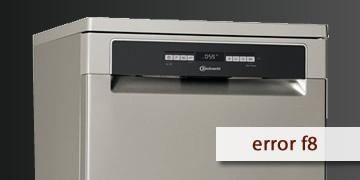Bauknecht Dishwasher Error f8
Index of contents

What is the F8 Bauknecht fault affecting your dishwasher?
Another issue related to the water inside your dishwasher! This kind of failure can occur in your appliance sooner or later. Remember that proper maintenance can extend the lifespan of your dishwasher and prevent such problems. Without further ado, let's explain this failure and try to find a solution.
The F8 error code on Bauknecht dishwashers indicates that there is a problem with the water draining into the drainage system. This can be due to several reasons that we will explain below. This fault can have different causes in your dishwasher's system, but all are related to water drainage.
Among the possible causes that can lead to this error code in Bauknecht dishwashers, we have the following:
- A dirty or clogged filter: The filter is the part inside the dishwasher responsible for catching food debris to ensure your system doesn't get clogged. If this filter gets too dirty, it will require a deep cleaning.
- Drainage tube bent or blocked: If the tube is not in good condition, then the water won't flow freely. It's crucial that this pipe is in good shape and isn't crushed or pinched by another appliance or against a wall.
- Water leak inside the dishwasher: A water leak can occur due to a break in some internal component of the dishwasher. Whether it's the tubing, the filter, or even the pump. It could also be due to a worn-out gasket that needs to be redone or replaced.
- Faulty water level sensor: A water sensor that might be damaged or burnt out. If this is your situation, you'll have to replace it with a new one. However, sometimes simple maintenance and some electronic cleaner could revive it. Remember, sensors might go haywire if the dishwasher has too much foam inside.
How to fix the F8 error of the Bauknecht dishwasher?
To resolve the F8 error code in Bauknecht dishwashers, we recommend you follow these steps listed below:
- Try restarting the dishwasher and waiting a few minutes: As simple as it sounds, a dishwasher reset might be the solution to your problem, as it resets all sensors. To do this, turn off the dishwasher and unplug it from the power supply for a few minutes. After waiting, plug it back in, turn it on, and see if the error has gone. If you don't have easy access to the wiring, you could also trip the circuit breaker that controls the kitchen's electrical supply. Don't worry, it'll only be off for a few minutes.
- Use less soap: Foam tends to interfere with sensors in most appliances. Try using less soap, or run a washing cycle with just water to see if the problem persists.
- Clean the drainage filter of the dishwasher: The filter captures all kinds of debris that might reach your dishwasher's internal system. Locate it (it's inside the dishwasher at the bottom), remove it, and if it looks dirty, clean it with warm water and a bit of vinegar. If the filter is broken or in poor condition, you'll need to replace it. Typically, these filters break when sharp food remains, like chicken or fish bones, tear through the protective mesh.
- Check the dishwasher's drainage pipe: This pipe shouldn't be squashed by the dishwasher itself, another appliance, or against your home's wall. It should have free circulation throughout the entire drainage system and not be bent, torn, or in poor condition. Also, check the seals and ensure everything is in good shape. If you find that the pipe is clogged, use a soft wire to try and clear it from the inside.
- Look for possible water leaks inside the dishwasher: Examine your dishwasher's entire drainage system. Look for water leaks, signs of moisture on the seals, and pipes. If you find leaks, you might attempt to repair them yourself with some putty or insulating tape on the seals. But if the leak issue is significant and/or recurring, it's best to call a professional.
- Check the water level sensor: If you're knowledgeable about electronics and can use a multimeter, locate this sensor and test its continuity to see if it's functioning correctly. Remember that excessive soap and foam can interfere with these sensors, so a little cleaning with an electronic cleaner might fix the issue.
- Review all the previously mentioned steps: If the problem persists, try everything again. It wouldn't hurt to have a more thorough check of all the steps we've described above. Make sure to follow everything precisely and don't overlook anything; leave nothing to chance!
- Contact Bauknecht's technical service: Don't get discouraged if you haven't been able to solve the problem on your own. Remember, it's always a good idea to leave things in the hands of experts. You can contact Bauknecht's technical support and schedule an appointment; we're confident they'll provide a fast, safe, and effective solution.
In summary, Bauknecht dishwashers are high-quality home cleaning appliances. But like all appliances, they need regular care and attention. Ensure you perform preventative maintenance as recommended by the manufacturer, and we're confident the dishwasher will serve you well in your kitchen.
To resolve the F8 error code in Bauknecht dishwashers, here's a brief summary of potential solutions:
- Try restarting the dishwasher
- Use less soap to produce less foam
- Clean the dishwasher's drainage or outlet filter
- Check the dishwasher's drainage pipe
- Look for possible water leaks inside the dishwasher
- Review everything again and follow the steps to the letter
- Seek support from Bauknecht's technical service